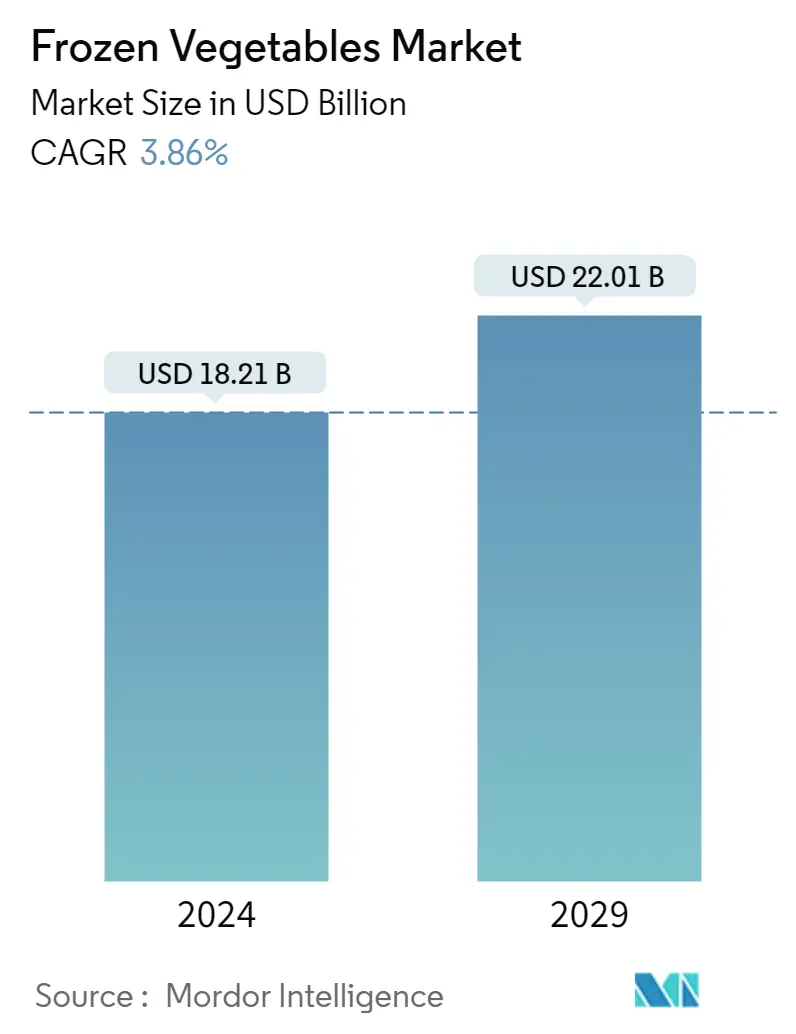Market Size of Frozen Vegetables Industry

| Study Period | 2019 - 2029 |
| Market Size (2024) | USD 18.21 Billion |
| Market Size (2029) | USD 22.01 Billion |
| CAGR (2024 - 2029) | 3.86 % |
| Fastest Growing Market | Asia Pacific |
| Largest Market | Europe |
Major Players
*Disclaimer: Major Players sorted in no particular order |
Frozen Vegetables Market Analysis
The Frozen Vegetables Market size is estimated at USD 18.21 billion in 2024, and is expected to reach USD 22.01 billion by 2029, growing at a CAGR of 3.86% during the forecast period (2024-2029).
- The rapid pace of urbanization, especially in the developing economies, coupled with growing disposable income and rising influence, has allowed convenience products to take center stage with regard to different fruits and vegetables. Altering technological advancements, along with aesthetic packaging, ease of storage, and all-around availability, are boosting the demand for frozen vegetables. The presence of well-balanced cold chain solutions and connected retail outlets have led to dramatic sales of the market, where most of the product portfolios are largely catered by local mid-and small-sized farms.
- Furthermore, this segment is gaining popularity as a preferred alternative to fresh, canned, and cooked food and healthy snack options among the millennial populations in the market.
- Due to the COVID-19, the frozen vegetable market has been performing well following the onset of the novel coronavirus. The fact that frozen vegetable is able to retain the nutritional value for a long period, and in turn, this helps bring down the number of times consumers have to visit the shop or outlet, which also works in favor of the market. Although the COVID-19 impact on the cold chain supply has been significant, the evolving buying patterns of the consumers with more inclination towards health have helped the frozen vegetable market develop faster than expected.
Frozen Vegetables Industry Segmentation
The frozen vegetables market is segmented by type, distribution channel, and geography. Based on type, the market is segmented into beans, corn, peas, mushroom, cauliflower, asparagus, broccoli, and other types. Based on distribution channels, the market is segmented into supermarkets/hypermarkets, grocery stores, convenience stores, and other distribution channels. Furthermore, the report takes into consideration the market for frozen vegetables in the established and emerging economies across the world, including North America, Europe, Asia-Pacific, South America, and Middle-East and Africa.
| By Type | |
| Beans | |
| Corn | |
| Peas | |
| Mushroom | |
| Cauliflower | |
| Asparagus | |
| Broccoli | |
| Other Types |
| By Distribution Channel | |
| Supermarkets/Hypermarkets | |
| Grocery Stores | |
| Convenience Stores | |
| Other Distribution Channels |
| By Geography | |||||||||
| |||||||||
| |||||||||
| |||||||||
| |||||||||
|
Frozen Vegetables Market Size Summary
The frozen vegetables market is experiencing significant growth, driven by urbanization and increasing disposable incomes, particularly in developing economies. The demand for convenience products, such as frozen vegetables, is rising due to technological advancements, appealing packaging, and ease of storage. These factors, combined with well-established cold chain solutions and retail networks, have enhanced market accessibility and sales. The market is particularly popular among millennials who prefer frozen vegetables as a healthy and convenient alternative to fresh, canned, and cooked foods. The COVID-19 pandemic has further accelerated market growth, as frozen vegetables retain nutritional value over time, reducing the frequency of shopping trips and aligning with the health-conscious buying patterns of consumers.
In Europe, the demand for frozen vegetables is fueled by time-pressed consumers seeking convenient meal solutions. The region's strong purchasing power and trend towards vegan and healthy foods are driving market expansion. European consumers are increasingly mirroring American food trends, leading to a rise in spending on frozen vegetables. The market is highly fragmented, with regional and international competitors like General Mills Inc., Conagra Brands, and ITC Brands vying for market share through diverse product offerings and strategic marketing. Key players are leveraging social media and online channels to enhance their brand presence and attract a broader customer base.
Frozen Vegetables Market Size - Table of Contents
-
1. MARKET DYNAMICS
-
1.1 Market Drivers
-
1.2 Market Restraints
-
1.3 Porter's Five Forces Analysis
-
1.3.1 Threat of New Entrants
-
1.3.2 Bargaining Power of Buyers/Consumers
-
1.3.3 Bargaining Power of Suppliers
-
1.3.4 Threat of Substitute Products
-
1.3.5 Intensity of Competitive Rivalry
-
-
-
2. MARKET SEGMENTATION
-
2.1 By Type
-
2.1.1 Beans
-
2.1.2 Corn
-
2.1.3 Peas
-
2.1.4 Mushroom
-
2.1.5 Cauliflower
-
2.1.6 Asparagus
-
2.1.7 Broccoli
-
2.1.8 Other Types
-
-
2.2 By Distribution Channel
-
2.2.1 Supermarkets/Hypermarkets
-
2.2.2 Grocery Stores
-
2.2.3 Convenience Stores
-
2.2.4 Other Distribution Channels
-
-
2.3 By Geography
-
2.3.1 North America
-
2.3.1.1 United States
-
2.3.1.2 Canada
-
2.3.1.3 Mexico
-
2.3.1.4 Rest of North America
-
-
2.3.2 Europe
-
2.3.2.1 Spain
-
2.3.2.2 United Kingdom
-
2.3.2.3 Germany
-
2.3.2.4 France
-
2.3.2.5 Italy
-
2.3.2.6 Russia
-
2.3.2.7 Rest of Europe
-
-
2.3.3 Asia-Pacific
-
2.3.3.1 China
-
2.3.3.2 Japan
-
2.3.3.3 India
-
2.3.3.4 Australia
-
2.3.3.5 Rest of Asia-Pacific
-
-
2.3.4 South America
-
2.3.4.1 Brazil
-
2.3.4.2 Argentina
-
2.3.4.3 Rest of South America
-
-
2.3.5 Middle-East and Africa
-
2.3.5.1 South Africa
-
2.3.5.2 Saudi Arabia
-
2.3.5.3 Rest of Middle-East and Africa
-
-
-
Frozen Vegetables Market Size FAQs
How big is the Frozen Vegetables Market?
The Frozen Vegetables Market size is expected to reach USD 18.21 billion in 2024 and grow at a CAGR of 3.86% to reach USD 22.01 billion by 2029.
What is the current Frozen Vegetables Market size?
In 2024, the Frozen Vegetables Market size is expected to reach USD 18.21 billion.

